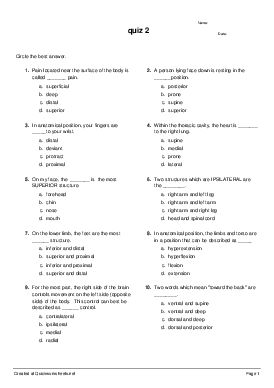quiz 2
Multiple Choice Worksheet
Kindly Shared By:
Date Shared: 6 January 2017
Worksheet Type:
Tags Describing Content or Audience:
Worksheet Instructions:
Circle the best answer.
Target Language or Knowledge:
Pain located near the surface of the body is called _______ pain.
A person lying face down is resting in the ______position.
In anatomical position, your fingers are _____to your wrist.
Within the thoracic cavity, the heart is _______ to the right lung.
On my face, the _______ is the most SUPERIOR structure.
Two structures which are IPSILATERAL are the ________.
On the lower limb, the feet are the most ______ structure.
In anatomical position, the limbs and torso are in a position that can be described as _____
For the most part, the right side of the brain controls movement on the left side (opposite side) of the body. This control can best be described as ______ control.
Two words which mean "toward the back" are ________.
Which words are NOT opposites:
The pointed tip of a structure that has a cone-like shape is the structure's _____.
When you have two matching structures on opposite sides of the body's midline (2 eyes, 2 ears, etc), these structures can be called:
If you start in anatomical position and bend all the joints (except the knee) toward the front (anteriorly), like you are curling up into the fetal position, the movement is called:
Which structure is AXIAL? (in other words, which structure is NOT appendicular -- or which structure is NOT considered an "appendage")
From your flash cards, inversion and eversion refer to movement at the
From your flashcards, ulnar deviation and radial deviation refer to movement at the
When you pull a limb in toward the body, you are ________
Backstroke is swum in the ______ position
Which type of doctor is likely to spend the most time examining deep structures?
superficial
deep
superior
distal
prone
supine
superior
posterior
distal
proximal
protract
deviant
medial
lateral
supine
prone
forehead
chin
nose
mouth
right arm and right leg
right arm and left leg
right arm and left arm
head and spinal cord
inferior and distal
superior and proximal
inferior and proximal
superior and distal
extension
flexion
hyperextension
hyperflexion
contralateral
ipsilateral
medial
radial
dorsal and posterior
dorsal and deep
ventral and supine
ventral and deep
dorsal and deep
prone and supine
superior and inferior
anterior and posterior
apex
base
bilateral
unilateral
flexion
extension
hyperextension
rotation
the head
the arm
the leg
ankle
neck & head
wrist
hip & leg
wrist
ankle
head & neck
hip & leg
adducting
abducting
supine
prone
surgeon
dermatologist
psychiatrist
Discussion Be the first to comment about this worksheet.
Please log in to post a comment.


Premium Download
You can download this worksheet by purchasing a plan.
It's easy and it's great value!
Already have a paid account?
To claim that this member-shared worksheet infringes upon your copyright please read these instructions on submitting a takedown request.


 Continue with Facebook
Continue with Facebook
 Continue with Google
Continue with Google


6 January 2017
bepeace Author